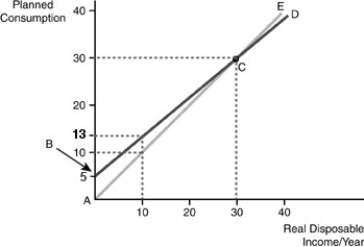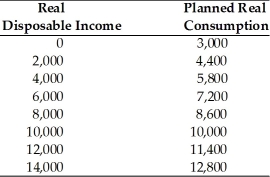A) $3,000.
B) $2,700.
C) $30,000.
D) $3,333.
Correct Answer

verified
Correct Answer
verified
Multiple Choice
One of the primary determinants of planned real investment spending is the
A) expectation of future profits.
B) rate of real consumption spending.
C) rate of real government spending.
D) rate of real saving.
Correct Answer

verified
Correct Answer
verified
Multiple Choice
In economics,the term "autonomous" means
A) existing independently.
B) non-economic related.
C) disposable income.
D) cash payments.
Correct Answer

verified
Correct Answer
verified
Multiple Choice
The equation  is the
is the
A) average propensity to consume.
B) average propensity to save.
C) marginal propensity to consume.
D) marginal propensity to save.
Correct Answer

verified
Correct Answer
verified
Multiple Choice
According to Keynes,
A) consumption is positively related to the interest rate.
B) consumption is directly related to income but saving is inversely related to income.
C) both consumption and saving are positively related to real disposable income.
D) consumption is directly related to income but saving has no relationship with income.
Correct Answer

verified
Correct Answer
verified
Multiple Choice
Because a decrease in real autonomous spending results in a ________ in the price level,the ultimate effect on real GDP is ________ that predicted by the multiplier.
A) fall;smaller
B) fall;larger
C) rise;smaller
D) fall,smaller
Correct Answer

verified
Correct Answer
verified
Multiple Choice
As real disposable income increases,consumption expenditures
A) increase by the same amount.
B) increase by a smaller amount.
C) increase by a larger amount.
D) remain constant.
Correct Answer

verified
Correct Answer
verified
Multiple Choice
Total planned expenditures in a closed economy are equal to
A) consumption + investment + government expenditures.
B) consumption + savings + transfers + investment.
C) saving + investment + government expenditures.
D) investment + saving + transfers.
Correct Answer

verified
Correct Answer
verified
Multiple Choice
A rise in the price level causes
A) an increase in aggregate demand.
B) a decrease in aggregate demand.
C) a reduction in total planned real expenditures.
D) an increase in total planned real expenditures.
Correct Answer

verified
Correct Answer
verified
Multiple Choice
If the marginal propensity to save (MPS) increases,the multiplier
A) decreases.
B) increases.
C) stays the same.
D) can either increase or decrease,depending on what happens to the marginal propensity to consume (MPC) .
Correct Answer

verified
Correct Answer
verified
Multiple Choice
An increase in the marginal propensity to save (MPS)
A) increases the value of the multiplier.
B) increases autonomous consumption.
C) increases the marginal propensity to consume (MPC) .
D) none of the above.
Correct Answer

verified
Correct Answer
verified
Multiple Choice
 -Refer to the above figure.If real disposable income is $30,000,saving is
-Refer to the above figure.If real disposable income is $30,000,saving is
A) $0.
B) $4000.
C) $5000.
D) $6000.
Correct Answer

verified
Correct Answer
verified
Multiple Choice
If real disposable income increases,the average propensity to consume will
A) initially increase,and then decrease.
B) remain constant.
C) increase.
D) decrease.
Correct Answer

verified
Correct Answer
verified
Multiple Choice
It is conceivable that the APC,APS,MPC,and MPS could simultaneously be
A) APC = 1.0;APS = 0.1;MPC = 0.8;MPS = 0.25.
B) APC = 0.8;APS = 0.2;MPC = 1.1;MPS = 0.1.
C) APC = 1.3;APS = -0.3;MPC = 0.9;MPS = 0.1.
D) APC = 1.0;APS = 0;MPC = 1.0;MPS = 0.15.
Correct Answer

verified
Correct Answer
verified
Multiple Choice
A permanent increase in autonomous investment causes
A) a more than proportional increase in real Gross Domestic Product (GDP) .
B) a proportional increase in real Gross Domestic Product (GDP) .
C) a less than proportional increase in real Gross Domestic Product (GDP) .
D) an offsetting change in saving that leaves real Gross Domestic Product (GDP) at the same level.
Correct Answer

verified
Correct Answer
verified
Multiple Choice
The investment function is represented by
A) an inverse relationship between the interest rate and the value of planned investment.
B) the direct relationship between the interest rate and the value of planned investment.
C) the direct relationship between taxes and government spending.
D) the indirect relationship between taxes and government spending.
Correct Answer

verified
Correct Answer
verified
Multiple Choice
Aging baby-boomers,predisposed to hearing loss because of years of listening to loud music,are now approaching the age range in which hearing loss starts to become apparent.What effect does this have on investment spending within the hearing aid industry?
A) There will no longer be an opportunity cost associated with investment spending.
B) There will be no change in real investment spending,because hearing aid manufacturers will look only at the interest rate in determining whether to expand production.
C) The investment function relating planned real investment spending to the interest rate can be expected to shift rightward.
D) The investment function relating planned real investment spending to the interest rate can be expected to shift leftward.
Correct Answer

verified
Correct Answer
verified
Multiple Choice
 -Refer to the above table.The table gives the combinations of real disposable income and real consumption for a college student for a year.What does planned real saving equal when real disposable income equals $6,000?
-Refer to the above table.The table gives the combinations of real disposable income and real consumption for a college student for a year.What does planned real saving equal when real disposable income equals $6,000?
A) -3,000
B) -1,200
C) 0
D) 7,200
Correct Answer

verified
Correct Answer
verified
Multiple Choice
When the average propensity to save (APS) is 0.20,then this means
A) people are spending 20 percent of their disposable income.
B) people are spending 80 percent of their disposable income.
C) people are saving $0.20 of the last dollar earned.
D) people are spending 60 percent of their disposable income and investing the remaining 20 percent.
Correct Answer

verified
Correct Answer
verified
Multiple Choice
Planned expenditures equal real disposable income
A) at every point on the consumption function.
B) at every point on the saving function.
C) at every point on the 45-degree line.
D) when saving equals zero.
Correct Answer

verified
Correct Answer
verified
Showing 301 - 320 of 445
Related Exams